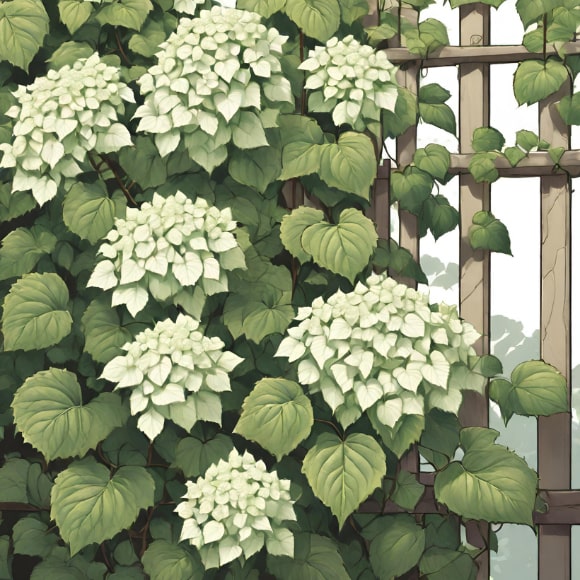
Overview
Climbing Hydrangea is a versatile and ornamental deciduous vine celebrated for its lush foliage, showy flowers, and ability to climb and cover various surfaces. This climbing hydrangea variety adds a touch of elegance to vertical spaces, making it a popular choice for trellises, walls, and arbors.
Description
Foliage
Climbing Hydrangea features dark green, glossy, heart-shaped leaves that provide a rich and textured backdrop to its cascading flower clusters. The foliage turns a yellowish hue in the Fall, adding to the plant’s visual appeal.
Flowers
The most distinctive feature of Climbing Hydrangea is its lacecap-like flower clusters, consisting of small fertile flowers surrounded by larger, sterile flowers. The flowers emerge in late Spring to early Summer and gradually change from creamy white to a light green, creating a captivating display.
Vines
The plant is adorned with aerial roots that allow it to climb and cling to surfaces. The vines can reach lengths of up to 80 feet, providing ample coverage for walls and structures.
Growing Conditions
Soil pH
Climbing Hydrangea thrives in slightly acidic to slightly alkaline soil conditions. A pH range of 6.0 to 7.5 is considered ideal for optimal growth and flowering. The plant’s adaptability to various pH levels makes it suitable for different soil types.
Sun Requirements
While Climbing Hydrangea can tolerate partial shade, it performs best in dappled sunlight to partial shade conditions. Planting in a location with morning sun and afternoon shade is often recommended. This ensures that the plant receives sufficient light for flowering while avoiding excessive heat.
Watering
Climbing Hydrangea appreciates consistently moist soil. Regular watering is crucial, especially during dry periods, to ensure the plant’s health and promote robust growth. Mulching around the base of the plant helps retain soil moisture and suppress weeds.
Hardiness Zones
Climbing Hydrangea is well-suited for planting in USDA hardiness zones 4 to 8. This range covers a variety of climates, making it adaptable to both colder and milder regions. The plant’s ability to withstand a range of temperatures makes it versatile and suitable for gardeners across different geographic areas.
Best Planting Time
The optimal time for planting Climbing Hydrangea is in the Spring or Fall when temperatures are moderate. Planting during these seasons allows the vine to establish a strong root system before facing more extreme weather conditions.
Maintenance Tips
To ensure the continued health and prolific flowering of your Climbing Hydrangea, consider these maintenance tips.
Pruning
Pruning is generally minimal for Climbing Hydrangea. Remove any dead or damaged wood in late Winter or early Spring. If necessary, light pruning can be done after flowering to control size and shape.
Fertilization
Climbing Hydrangea is not heavy feeder. A balanced fertilizer applied in Spring can support overall growth. Avoid excessive fertilization, as too much nitrogen can lead to lush foliage at the expense of flowers.
Mulching
Mulch around the base of the plant with organic materials like shredded bark or compost. Mulching helps retain soil moisture, suppress weeds, and maintain a consistent soil temperature.
Support Structures
Provide a sturdy and supportive structure for the vines to climb. Ensure that the support is in place during the early stages of growth to guide the vines in the desired direction.
Regular Monitoring
Keep an eye on soil moisture levels, especially during hot and dry periods. Regular monitoring allows you to adjust watering practices, ensuring that the plant receives adequate hydration.
Landscaping Uses
Climbing Hydrangea offers versatility in landscaping designs. Here are some popular uses in garden settings
Vertical Gardens
Ideal for covering walls, fences, and trellises, Climbing Hydrangea adds a vertical dimension to garden designs.
Shade Gardens
Planted in shaded areas, this vine thrives and provides a lush, green backdrop with its glossy foliage.
Arbors and Pergolas
Climbing Hydrangea can be trained to climb over arbors and pergolas, creating a charming and shaded retreat.
Cottage Gardens
Adds a cottage-garden charm when allowed to cascade over low structures or grow along garden pathways.
Naturalized Settings
Planting Climbing Hydrangea in naturalized settings allows it to climb and spread, creating a picturesque and informal landscape.
Climbing Hydrangea, with its climbing ability, lush foliage, and delicate flowers, stands as an enchanting addition to gardens with vertical spaces. Its adaptability to different soil and light conditions makes it a versatile choice for various garden settings. By understanding its specific soil, sun, and watering requirements, gardeners can enjoy the graceful beauty of Climbing Hydrangea and transform ordinary structures into stunning focal points in the landscape.


 Previous
Previous

